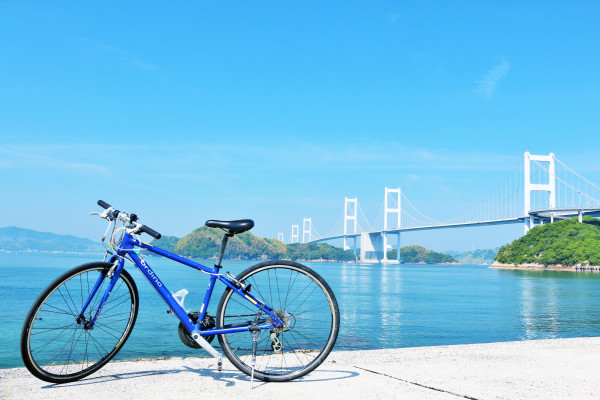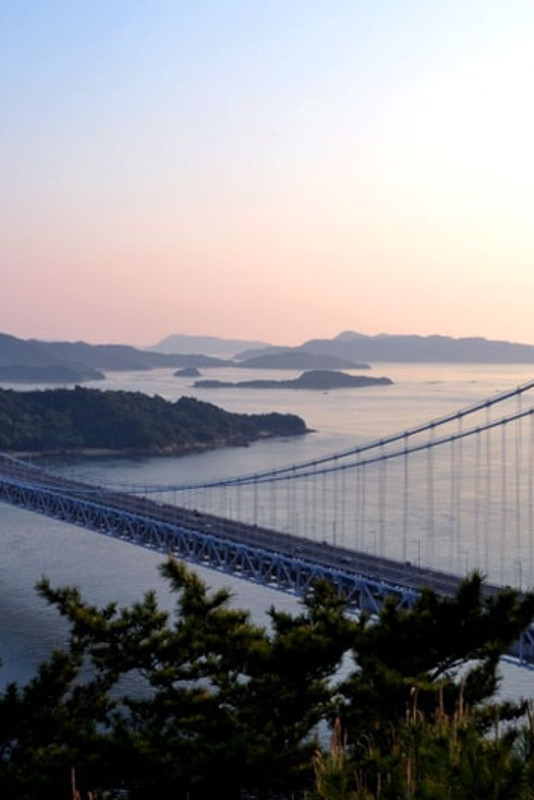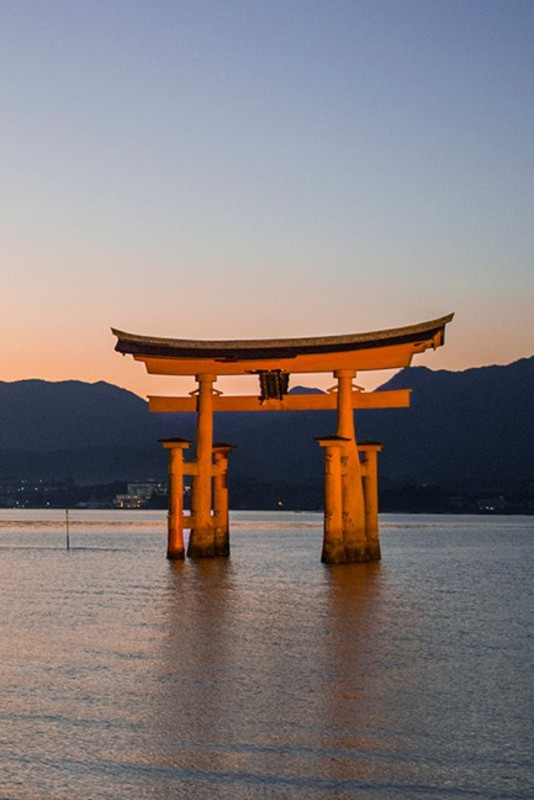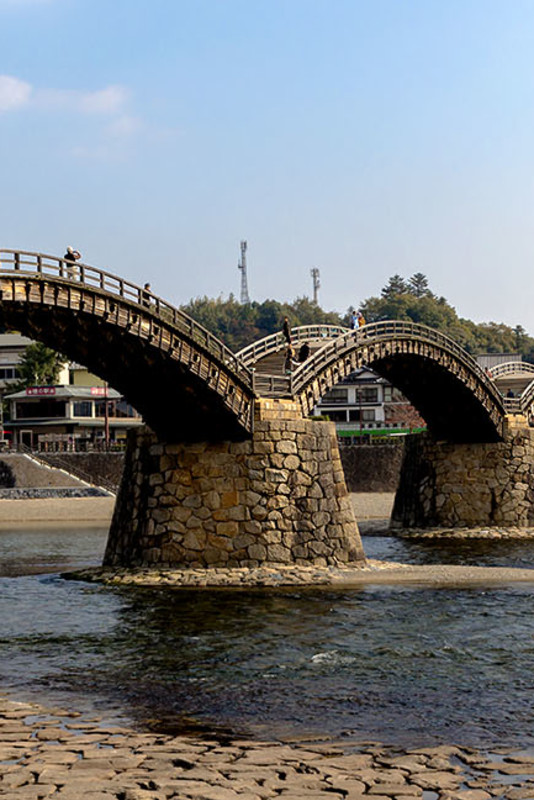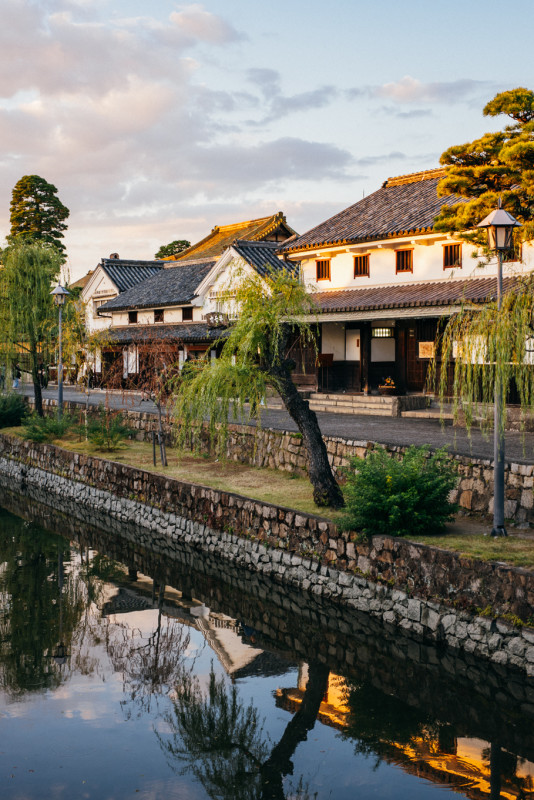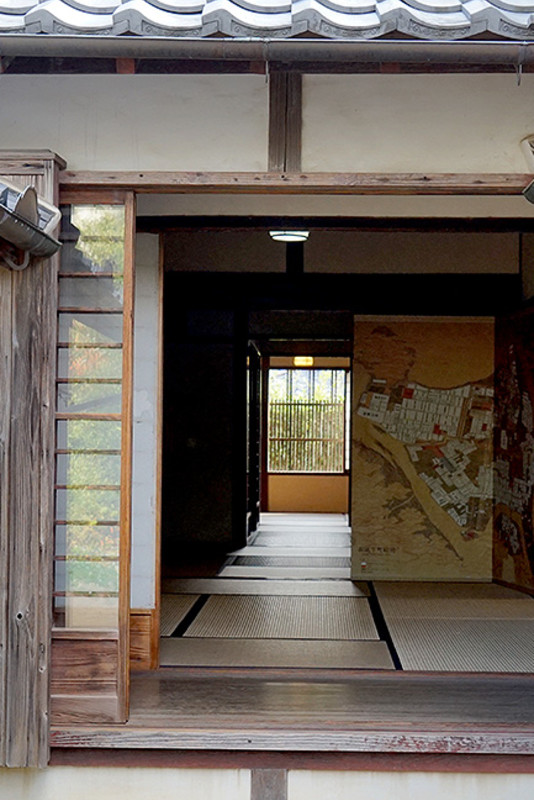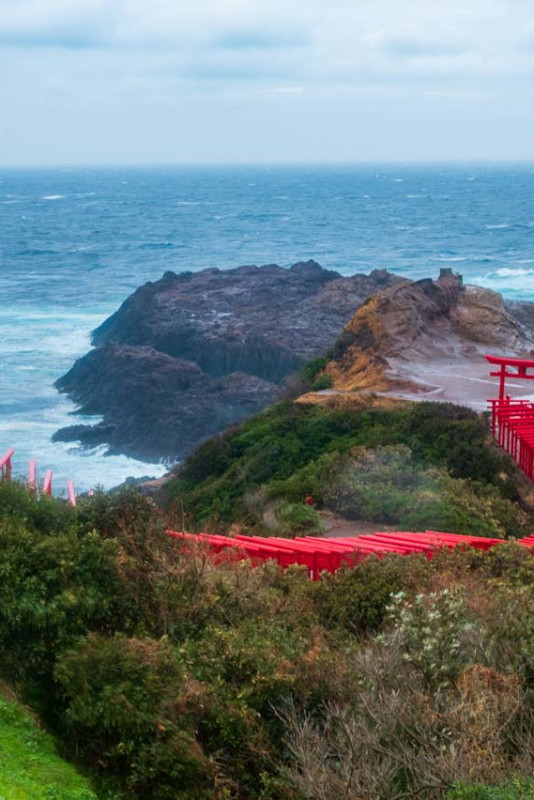Itineraries
World Heritage and Michelin Guide Favorites of Western Setouchi in Four Days

As well as the World Heritage Sites of the Hiroshima A-bomb Dome and Miyajima this varied four-day itinerary takes in one of Japan’s oldest hot springs, island-hops the stunning Shimanami Kaido to Onomichi, and concludes with Iwakuni’s beautiful five-arched wooden bridge.
- Day 1
- Matsuyama
Travel: Osaka to Matsuyama
・Take the Shinkansen from Shin-Osaka Station to Okayama Station (Approx 50 minutes)
・Take the Shiokaze Limited Express from Okayama Station to Matsuyama Station (Approx 2 hours 40 minutes)
・You can also take a 50-minute flight from Itami Airport in Osaka to Matsuyama Airport from where it is a 20 minute bus ride into central Matsuyama.
Matsuyama Castle, Dogo Onsen and Ishiteji Temple
Located on the western edge of Shikoku, Matsuyama is a city blessed with a host of cultural and historical landmarks waiting to be discovered. Start with a trip to the iconic Matsuyama Castle, an impressive hilltop castle with panoramic views of the city.
10 minutes by streetcar ride is Dogo Onsen – one of Japan’s oldest hot spring resorts and the inspiration for Studio Ghibli’s film Spirited Away. The original hot spring onsen is still in operation and open to the public. They also offer guided tours around the facility, including a look at the special bath constructed exclusively for the emperor’s private use. Next to the onsen, you can enjoy a glass of locally brewed Dogo Beer while soaking your feet in a foot bath.
Eclectic Ishiteji Temple is one of the 88 temples on the famous Shikoku Ohenro Pilgrimage route and is only a short distance from Dogo Onsen. As you go around Shikoku, you will undoubtedly spot pilgrims with their distinctive straw hats, white robes and walking stick trekking between temples. Visiting Ishiteji Temple is a way to experience a tiny part of this vast journey that attracts pilgrims from all over the world.
Matsuyama’s sea bream rice and goshiki somen noodles
Matsuyama is known for its delicious cuisine and these two dishes are held in high esteem. To create the sea bream rice (tai-meshi), sea bream and kelp are slow-cooked with the rice, infusing the whole dish with umami-rich flavors. Before serving, some regions around Matsuyama arrange raw slices of sea bream on top while others mix carrot and fried tofu into the rice.
Goshiki somen noodles come in five bright colors – brown, green, red, yellow and white. They achieve the different colors by kneading various ingredients into the noodles, such as matcha tea, mandarin oranges and ume plums.
Both goshiki somen noodles and sea bream rice can be ordered at Goshiki, 5 minutes walk south of Okaido streetcar stop fairly close to Matsuyama Castle.
Accommodation: Yamatoya Besso
Nestled in the heart of Matsuyama, Yamatoya Besso is an elegant ryokan hotel steeped in Japanese tradition and hospitality. The ryokan's rooms are built entirely out of Japanese cypress creating a calming atmosphere. The attentive staff will welcome you and attend to your every need during your stay. You can also indulge in the culinary delights of Yamatoya Besso, where kaiseki meals are skillfully crafted with the finest local ingredients.
URL: https://yamatoyabesso.com
- Day 2
- Shimanami Kaido
Travel: Matsuyama to Imabari
・Take a limited express train from Matsuyama Station to Imabari Station (Approx 40 minutes)
Shimanami Kaido
The Shimanami Kaido is Japan’s premier cycling destination, a stunning 70 km island-hopping route that connects Imabri on Shikoku with Onomichi in Honshu via a series of impressive bridges. As well as stunning views, the Shimanami Kaido has many fascinating places to visit along the way. Several rental cycles services are available, some of which allow you to drop off bikes at either end of the route, or at cycle terminals along the way. Charter taxis or cycle support services allow for more flexibility and can bring peace of mind.
The Kurushima Straits Bridges
Starting from the Imabari side of the Shimanami Kaido, the first of the route’s six bridges is its most impressive. Actually a series of three bridges, the entire span is around 4 kilometers. The cycle path offers incredible views of the swirling waters of the straits below and island beyond and, if you are short on time, the ride across the bridge and back from the rental bicycle terminal next to Sunrise Itoyama is a worthwhile outing. Special tours (Japanese) which take you to the top of one of the 184m tall bridge towers are offered several times a year.
Art, culture and history along the Shimanami Kaido
It is an approximately 35-km bike ride along the Shimanami Kaido “Blue Line” from Kurushima Straits Bridge to the picturesque port town of Setoda.
On the island of Oshima, learn about the history of the Murakami Suigun, seaborn samurai who controlled local waters, at the Murakami Suigun Museum. You can also take a cruise to experience the swirling currents that protected their island strongholds.
Those with strong cycling legs, a support vehicle, or traveling by car, might consider adding a loop of Omishima Island. The largest of the Shimanami Islands boasts several art museums with incredible views along its undulating west coast and the charming Oyamazumi Shrine, a sacred site renowned for its impressive collection of samurai armor and weaponry.
Today’s final destination is the picturesque port town of Setoda on Ikuchijima Island. Wander the sleepy Shiomachi shopping street and check out the fascinating temple complex of Kosanji, known for its colorful architectural motifs and serene atmosphere. Finally, quieten the mind with Zen meditation and sutra copying at Kojoji Temple.
Accommodation: Azumi Setoda
When it became known that the founder of Aman resorts, Adrian Zecha, was to be involved in the restoration of a 140-year-old former home of a wealthy salt merchant, the whole region was abuzz with excitement. The resulting Azumi Setoda respects and maintains the style of the original buildings while providing exceptional levels of comfort that will satisfy the most discerning of travelers. Four types of rooms are built around a calming courtyard, each with its own bathtub made of cypress wood, including two-story maisonette accommodation. Expert chefs prepare French-inspired meals made with local ingredients sourced as far as possible from within 50km.
URL: https://azumi.co/setoda/
- Day 3
- Onomichi and Hiroshima
Travel: Setoda to Onomichi
・Take the ferry from Setoda Port to Onomichi (Approx 40 min)
Explore Onomichi, town of temples, cats and bicycles
Whether you visit the temples and cats on Mt Senkoji, the retro shopping arcade, or the stylish boutique hotels and restaurants, Onomichi has something for everyone. Begin your adventure at Onomichi U2, a repurposed warehouse that has been transformed into a must-visit destination. The complex boasts stylish shops, a restaurant and the Hotel Cycle – a chic hotel designed and built for cyclists.
Ride the ropeway to the top of Mt Senkoji for a panoramic view of Onomichi and Mukaishima Island across the strait and say hello to the cats along Neko no Hosomichi (Cat Alley) on the way down. Stroll along the retro shopping arcade and explore the maze of alleyways branching off the main street.
Seek out Tea Stand Gen, a charming tea shop with a loyal fanbase who travel from far and wide to sample the delicious organically grown teas. Those who prefer something a little stronger might like to check out Onomichi Brewery, run by a friendly couple who use local agricultural by-products and produce in the brewing process. Join one of the lines that snake from the town’s most popular shops serving the town’s soul food, Onomichi Ramen, made with soy sauce based soup, locally caught fish and pork fat.
Travel: Onomichi to Hiroshima
・ Take a local train from Onomichi Station to Mihara or Fukuyama (Approx 15-20 minutes)
・ Take the Shinkansen from Mihara Station or Fukuyama Station to Hiroshima Station (Approx 20-30 minutes)
・ Alternatively, take a taxi to Shin-Onomichi Station (Approx 10 minutes) and take the Shinkansen from Shin-Onomichi Station to Hiroshima Station (Approx 40 minutes)
Learn about the Hiroshima A-bombing and the city’s recovery
Visiting Hiroshima’s Peace Memorial Park, Peace Memorial Museum and Atomic Bomb Dome Memorial World Heritage Site is a sobering and often emotional experience. If time allows, seek out a quiet spot among the trees to reflect on the experience before returning to the hustle and bustle of the city.
Sokoiko! Peace Cycle Tour
Starting from Peace Memorial Park, friendly local guides lead you around central Hiroshima, stopping at significant sites related to the A-bombing. Focusing on the city’s recovery as well as on the tragedy of the bombing, the Sokoiko! Peace Cycle Tour is a moving experience that is highly rated by visitors from around the world.
URL: https://www.sokoiko-mint.com/
Hiroshima Okonomiyaki
There is no better place to experience how welcoming the people of Hiroshima are, than at the grill in a local okonomiyaki shop. It is no exaggeration that most of Hiroshima’s population was raised on this hearty layered pancake and watching it being prepared by a veteran chef is as entertaining as the finished dish is delicious. Vegan diners can also enjoy the full okonomiyaki experience at Nagataya and Jirokichi.
Bar hopping in Eki Nishi
To raise a glass with the locals after dark, head to Eki Nishi, a small area crammed with bars and eateries next to Hiroshima Station.
Accommodation: Hilton Hiroshima
A short taxi ride from Hiroshima Station and within walking distance of Hiroshima Peace Memorial Park, the Hilton Hiroshima is the perfect place to base yourself during a visit to Hiroshima. With well-appointed, modern rooms, and excellent guest facilities, the Hilton Hiroshima is a luxurious refuge in which to relax, recharge and ready yourself to explore the city or head to your next destination.
Four restaurants serve Japanese and international cuisine using locally sourced ingredients. In the Executive Lounge on the 22nd floor, guests can enjoy evening cocktails and light snacks, as well as a variety of beverages, while taking in the views over islands of the Seto Inland Sea and surrounding mountains.
A guest relations officer is also on hand to provide assistance with sightseeing and restaurant reservations. Take the relaxation up another level with a visit to the luxurious Spa by L’OCCITANE.
URL: Hilton Hiroshima
- Day 4
- Miyajima and Iwakuni
Travel: Hiroshima to Miyajima
・Take the local train from Hiroshima Station to Miyajima-guchi Station (Approx 30 minutes)
・Take the ferry from Miyajima-guchi to Miyajima (Approx 10 minutes)
World Heritage Sea Route
High speed ferries make the journey between Hiroshima’s two UNESCO World Heritage Sites in approximately 45 minutes. Hiroshima departures are from Peace Memorial Park, just south of the A-bomb Dome Memorial. Please check the website as schedules change according to the tides.
URL: http://www.aqua-net-h.co.jp/en/heritage/
Explore the sacred island of Miyajima
A sacred site since time immemorial, originally built in its current form some 800 years ago, Itsukushima Shrine on the island of Miyajima is the first of two UNESCO World Heritage Site on this itinerary. The huge vermilion shrine gate which stands in the water is one of the most iconic sights in Japan. Be sure to check tide time on the day of your visit. The sight of Itsukushima Shrine and the “floating” shrine gate at high tide is one that will never be forgotten. Low tide offers the opportunity to walk out to see the towering shrine gate up close.
The area around the shrine is crowded with many ancillary temples and shrines which well-illustrate the long interconnected history of Buddhism and Shinto before separation was enforced in 1868. Overlooking Itsukushima Shrine is the impressively unfinished Senjyokaku 1000 Mat Pavilion and the Five-storied Pagoda which stands next to it. At the base of Mt. Misen (also part of the UNESCO World Heritage Site) is the fascinating Shingon Buddhist temple complex of Daishoin.
Kimono and culture workshops in a local temple
OKEIKO Japan offers opportunities to dress in authentic kimono and experience tea ceremony, calligraphy and even cooking, within the confines of a pretty temple.
URL: https://okeiko-japan.com/en
Eat your way around Miyajima
A big draw for visitors to Miyaima is the wide variety of restaurants and street food available. Local specialities such as plump grilled oysters, conger eel and maple leaf shaped Momiji-manju sweet bean cakes can be had along lively Omotesando, while a more relaxed vibe can be enjoyed on the quieter Machiya Street which runs parallel to Omotesando. Miyajima Brewery serves craft beer brewed on site with good views of the great shrine gate.
Travel: Miyajima to Iwakuni, Kintaikyo Bridge
・Take the ferry from Miyajima Ferry Terminal to Miyajima-guchi Ferry Terminal (Approx 10 minutes).
・Take the local train from Miyajima-guchi Station to Iwakuni (Approx 20-40 minutes).
・Kintaikyo Bridge is approx 12 minutes by taxi or 30 minutes by local bus from Iwakuni Station.
Kintaikyo, one of the most beautiful bridges in Japan
Kintaikyo Bridge in Iwakuni is a historic wooden bridge with five arches spanning the Nishiki River and is considered one of the most beautiful bridges in Japan. The original bridge was built in 1673 and while it has been damaged and washed away a few times, the integrity of the original design has been maintained. The shape and the location of Kintai Bridge have not changed in over 300 years.
As well as walking across the bridge, be sure to appreciate the intricate, and beautiful, woodwork from beneath too. The riverside here is particularly pretty during cherry blossom season, and, if your schedule allows you to linger until dusk, the bridge is illuminated most evenings of the year and displays of traditional cormorant fishing are conducted on summer evenings.
Kikko Park & Iwakuni Castle
Kintaikyo takes you into Kikko Park, which now occupies that area where the feudal lords of Iwakuni used to live. It is a lovely area to walk around, enjoying the preserved historical buildings and seasonal flowers which add color throughout the year. The Kashiwabara Art Museum, located next to the Iwakuni Castle Ropeway Station, contains an amazing collection of samurai swords and armor. One of Iwakuni’s more unusual attractions are its white snakes which are venerated as a guardian deity of households and can be seen in the White Snake Museum here. The ropeway whisks you up to Iwakuni Castle. Although the current keep is a reconstruction that dates only from 1962, the high vantage point offers a fantastic view of the Kintaikyo Bridge and the river below.
Iwakuni Sushi, Sake and Samurai Dress Up
On the other side of the bridge Honke Matsugane, a tourist information center where you can try on samurai armor, sample some local Iwakuni sake and local dishes. Everything is sample -size so you can try local cuisine and still have room for lunch or dinner. Be sure to try lotus root and Iwakuni Sushi. Iwakuni is known for its lotus fields which uniquely produce lotus root with nine rather than the usual eight holes). Iwakuni Sushi is a mix of rice, eggs, veggies, and seasonings that is pressed down until it kind of looks like a sushi cake.
Before you leave Iwakuni
One of the most fun places to eat in this part of Japan is Irori Sanzoku. People drive from far and wide to experience the festival-like atmosphere of this ebullient imagining of a sprawling mountain bandit encampment. Signature dishes – Sanzoku grilled chicken, udon noodles and giant rice balls — may be simple, but they are very tasty and a meal at Sanzoku is always a memorable experience.
At Murashige Sake Brewery, a short walk from Shin-Iwakuni Shinkansen station, as well as marveling at the world’s biggest sugi-dama (the cedar balls that you see hanging in front of sake breweries and shops), you can enjoy sake tastings, try sweets made from sake and sake lees and pick up unique souvenirs.



























































































